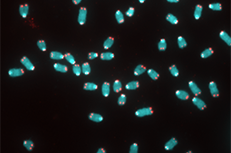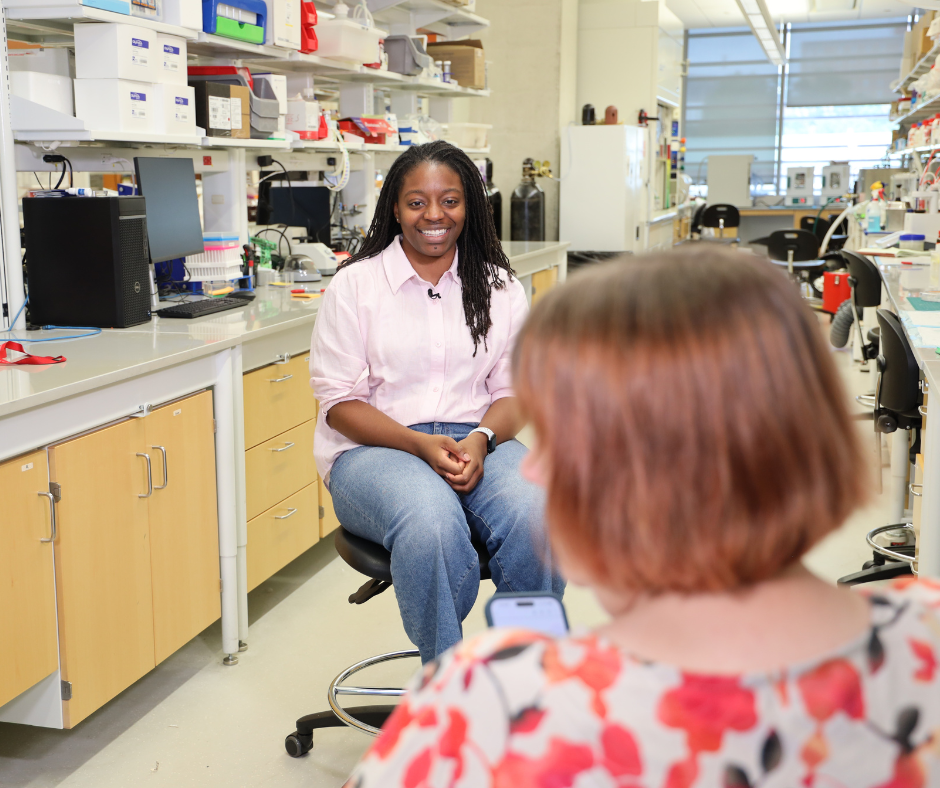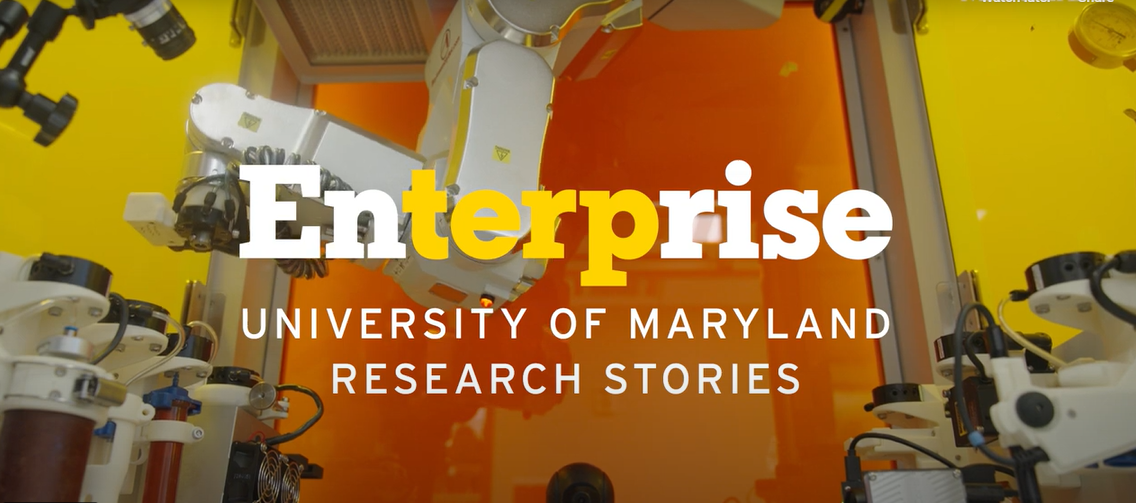News Story
Enzyme Known for Promoting Cancer Found to Protect Healthy Cells

In this image, captured by confocal microscopy, the ends of telomeres can be seen as red dots aligning at opposite sides of blue chromosomes in skin cells that are preparing to divide. A new study from UMD researchers revealed that telomerase, an enzyme that prevents telomere shortening as cells divide and is known to promote cancer, also protects against malignant transformations in a key stage at the end of a cell's life. Photo credit: Kan Cao, University of Maryland.
New research from the University of Maryland and the National Institutes of Health reveals a new role for the enzyme telomerase. Telomerase's only known role in normal tissue was to protect certain cells that divide regularly, such as embryonic cells, sperm cells, adult stem cells and immune cells. Scientists thought telomerase was turned off in all other cells, except in cancerous tumors where it promotes unlimited cell division.
The new study found that telomerase reactivates in normal adult cells at a critical point in the aging process. Just before cell death, a burst of telomerase buffers cells from the stresses of aging, slowing the process and reducing DNA damage that could lead to cancer. The study was published in the Proceedings of the National Academy of Sciences on September 2, 2019. Fischell Department of Bioengineering (BIOE) postdoctoral associate Ji Young (Julie) Choi served as a co-author on the paper.
"This study reshapes the current understanding of telomerase's function in normal cells," said Kan Cao, senior author of the study and an associate professor of cell biology and molecular genetics at UMD. "Our work shows, for the first time, that there is a role for telomerase in adult cells beyond promoting tumor formation. We can now say that regulated activation of telomerase at a critical point in a cell's life cycle serves an important function."
Telomerase prevents the shortening of telomeres--a specialized DNA-protein structure at the end of a cell's chromosomes that protect the chromosomes from damage. Telomerase plays a critical role during embryonic development and stem cell differentiation, when cells divide profusely. In normal adult cells, telomerase is turned off and telomeres shorten with every cell division until they reach a critical length. At critical telomere length, cells stop dividing and either die or experience DNA damage that could cause malignancies.
Before this new work, scientists thought that telomerase expression in most adult cells could only lead to unlimited cell division like that seen in cancerous tumors.
Cao and her colleagues suspected telomerase may have a function in adult cells when they observed dramatic differences in the laboratory among sibling mice with shortened telomeres. The mice were the progeny of wild-type mice and genetically modified mice that had been bred for many generations without the ability to produce telomerase. All the siblings had abnormally short telomeres, but the researchers found that mice that had not inherited the gene to produce telomerase from their wild-type parent exhibited shorter lifespans, progressive tissue atrophy and spontaneous cancers.
To understand what was going on, Cao and her colleagues compared the skin cells of the sibling mice and found that while both cell lines had comparably short telomeres, cells from telomerase-deficient mice stopped dividing sooner and had more malignant transformations than cells from siblings that produced telomerase.
What's more, the researchers found that as skin cells from non-telomerase-deficient mice approached critical telomere length, they naturally produced a burst of telomerase, which slowed the process of telomere shortening and reduced the amount of DNA damage that could lead to cancer. According to Cao, these results suggest that telomerase expressed near the end of a cell's lifespan softened the blow of aging and led to a more gradual cell death.
The researchers also found that reactivating the gene for expressing telomerase in the telomerase-deficient cells rescued them, prolonging their ability to divide and reducing DNA damage.
To see if what they observed in mice held true for humans, the team conducted laboratory studies on human skin cells. The researchers found that human cells also expressed telomerase as they approached critical telomere length. In addition, human skin cells that were unable to express telomerase reached critical telomere length more quickly and displayed significantly more DNA damage than those that did express telomerase.
Cao said that the next step for researchers is to find out how telomerase expression is turned on as cells approach critical telomere length and to explore the underlying mechanisms by which telomerase acts as a buffer against the stresses of shortening telomeres.
###
Additional co-authors of the research paper from UMD include Department of Cell Biology and Molecular Genetics postdoctoral associate Linlin Sun and Assistant Research Professor Zheng-Mei Xiong, and biological sciences graduate candidate Xiaojing Mao.
This work was supported by the National Heart, Lung, and Blood Institute (Award No. R01HL126784) and the National Institutes of Health Intramural Research Fund. The content of this article does not necessarily reflect the views of this organization.
The research paper, "Transient induction of telomerase expression mediates senescence and reduces tumorigenesis in primary fibroblasts," Linlin Sun, Jeffrey Chiang, Ji Young Choi, Zheng-Mei Xiong, Xiaojing Mao, Francis S Collins, Richard J Hodes, and Kan Cao, was published in the September 2, 2019, issue of the Proceedings of the National Academy of Sciences.
###
Media Relations Contact:
Kimbra Cutlip, (301) 405-9463
University of Maryland
College of Computer, Mathematical, and Natural Sciences
2300 Symons Hall
College Park, Md. 20742
Published September 3, 2019









